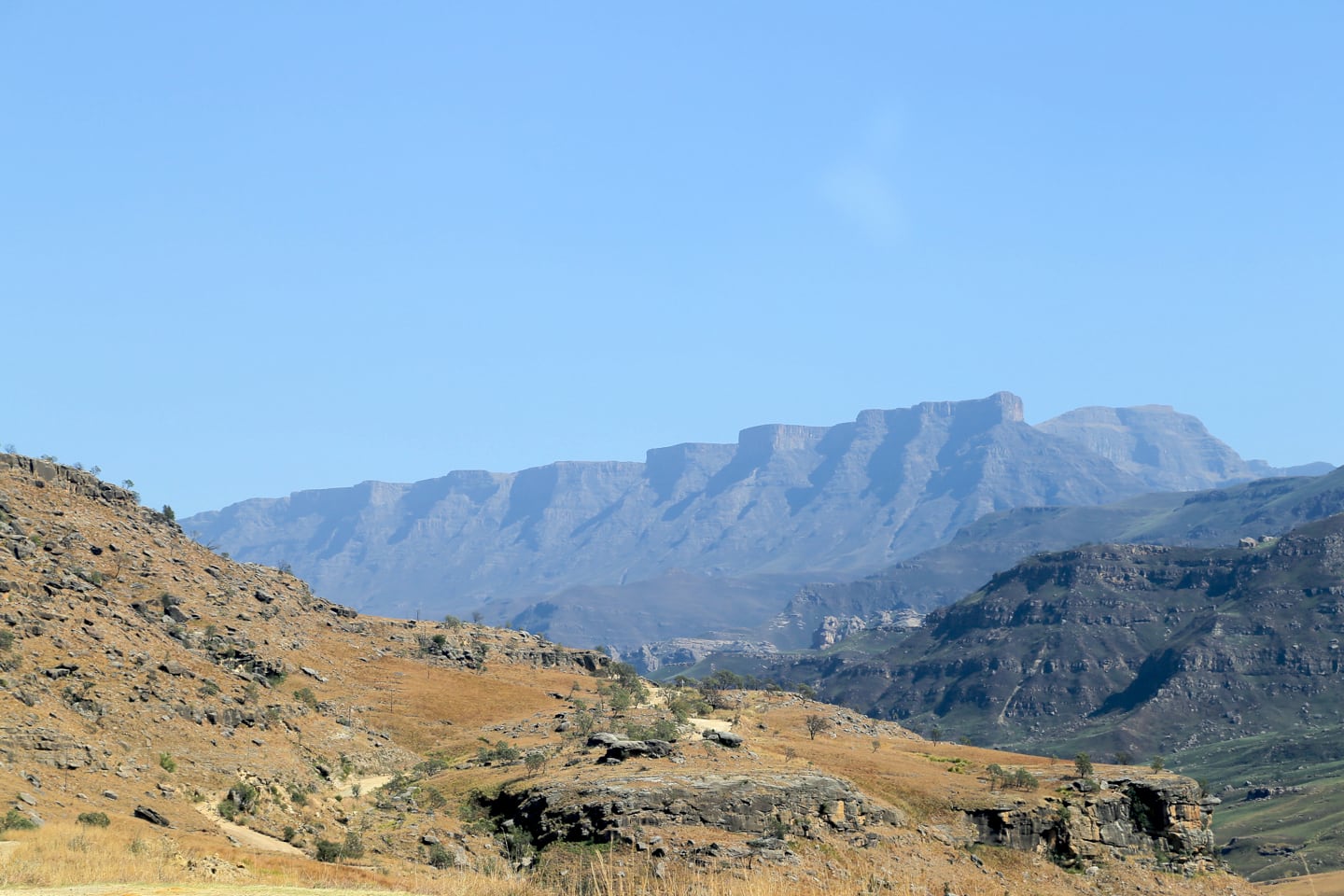
Lori has a gift for arranging memorable birthdays. I think it helps a bit that we’ve already been finding ourselves in awesome places around my birthday the last three years, so she has had a lot to work with but certainly doesn’t squander any opportunities.
This year, we woke up early and climbed in a 4×4 Land Rover Defender, the quintessential African Safari rig, and spent the day off the tarmac and high up in the mountains straddling two countries.
The day began in South Africa at Sani Lodge at just over 5,000 feet, climbed to 9,400 feet at the Lesotho border, adding another 1,200 feet to the highest point where we stopped for lunch and a view.
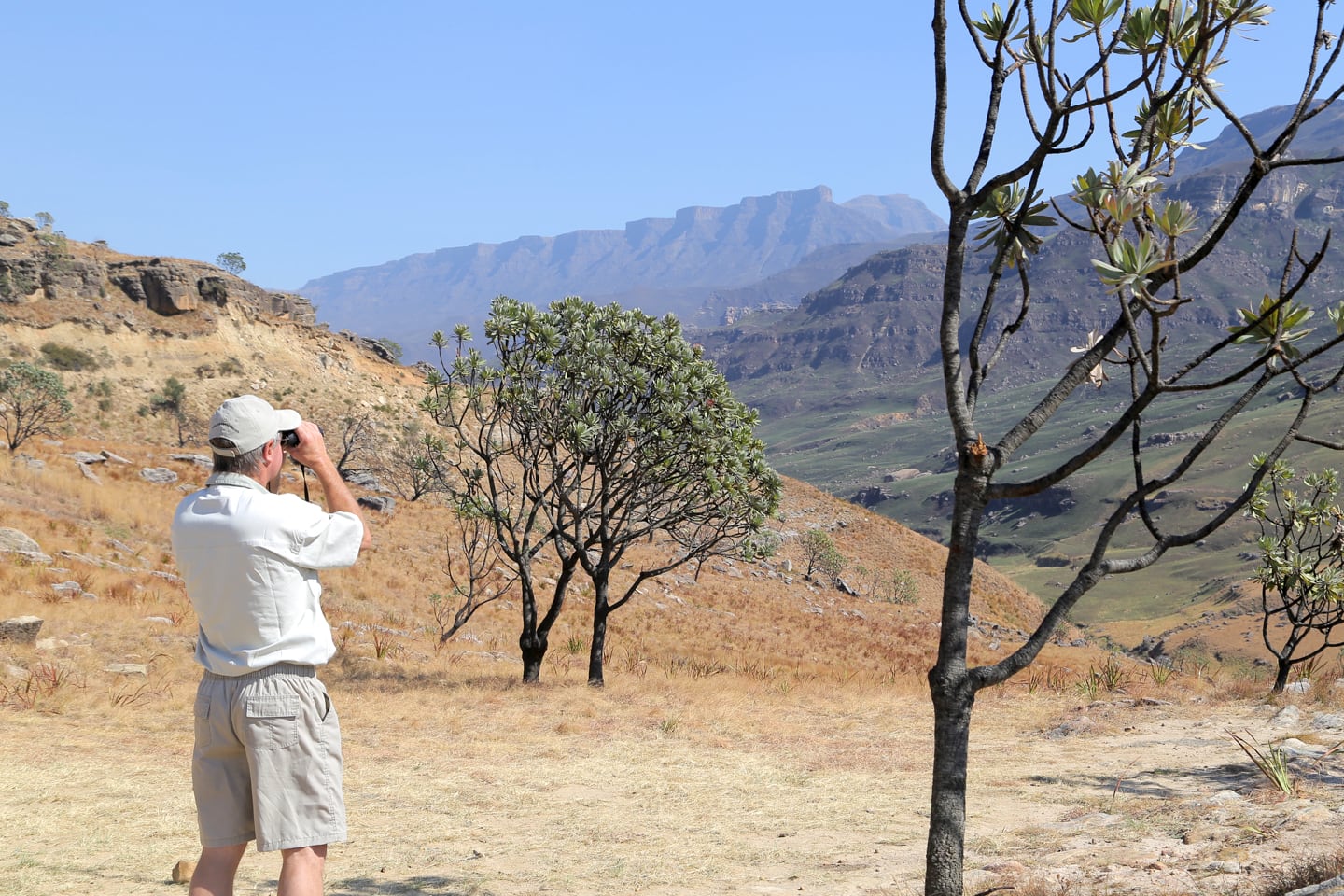

I did a somewhat similar trip in 2005 with my sister, but from Amphitheatre Backpackers in the Northern Drakensberg.
We took a 4×4 vehicle up and over a rarely used mountain border crossing into Lesotho, but that’s where the similarities end.
Both day trips have their advantages. But today, this trip was perfect.
We spent the day being driven around in a Defender by a very knowledgeable guide from the area, spotting unique birds, taking in the amazing scenery, visiting a local trading post and, most importantly, having a beer at the highest pub in Africa!


In addition to a number of different birds, Stewart spotts a variety of other wildlife for us, including these baboons across the gorge.
There are about half a dozen in this picture that could easily be mistaken for rocks. Can you spot them all?

We noticed on our hike the previous day that hillsides appeared to change color dramatically — from bright yellow to bright green — along what appeared to be an artificial line.

Here in this valley, the contrast is even more stark from one side of the river to other.
Apparently, landowners (and government officials) are obliged to conduct controlled burns on their land at regular intervals. This minimizes the threat of uncontrolled wildfires and causes the soil to become more fertile.
The deep green side is a result of a recent controlled burn, while the yellow side has not been burned in some time.

Stewart said that if any of us could spot and show him a leopard, that he would buy us as many beers as we want — in his decade of leading tours in the area (and many more decades living here), he hasn’t spotted a leopard, himself.
But evidence abounds to indicate they do still inhabit this area, like the scat left behind by leopards.
Upon inspection, Stewart determines that this is not leopard scat, but perhaps something else of intrigue that we should be on the lookout for.
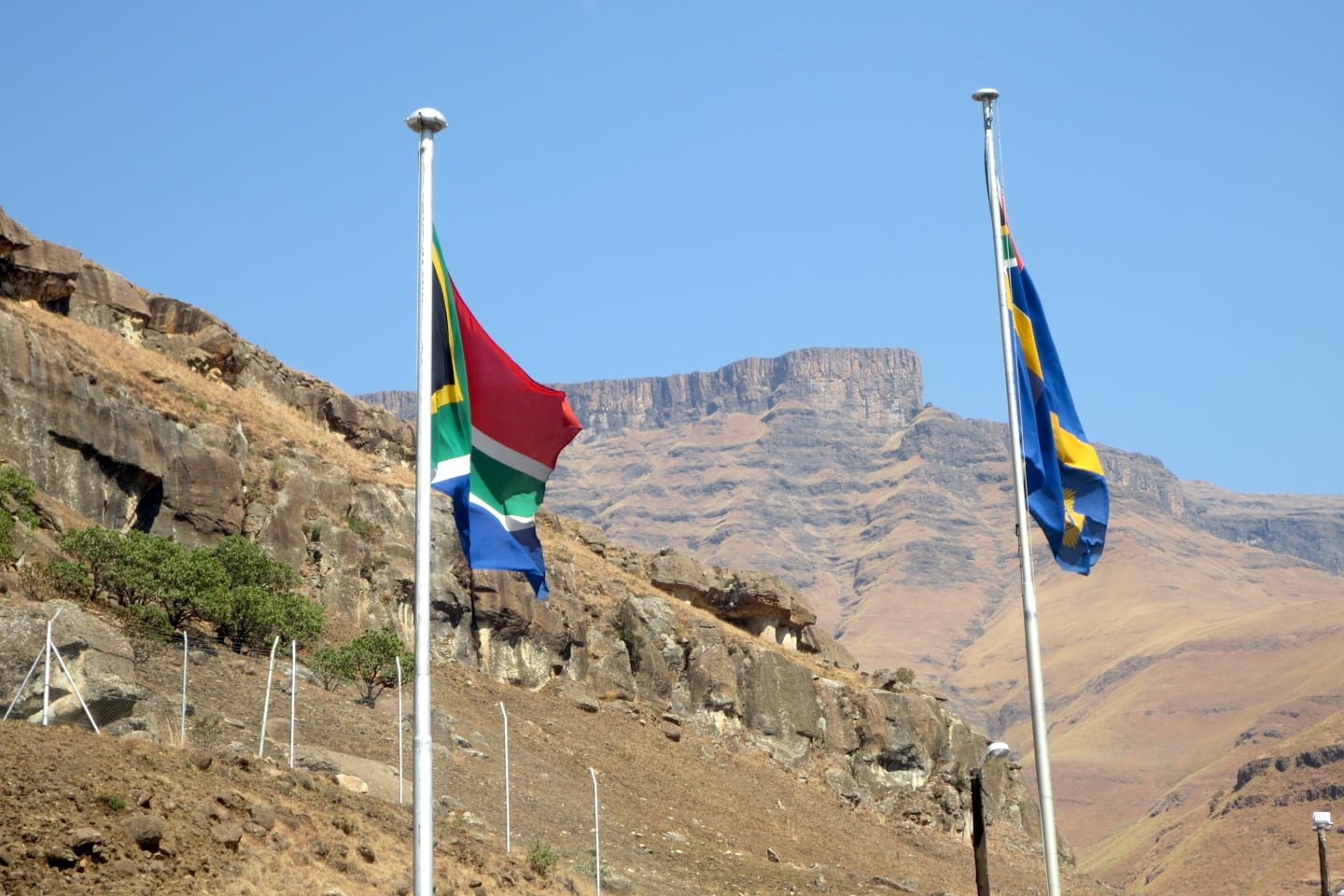
The South Africa border post is not at the actual border at the summit of the pass, but many miles beforehand near the bottom of the valley.
Apparently, the South African government officials didn’t want to have to drive to the top of the Pass every day.
After heading up there ourselves, we didn’t blame them.
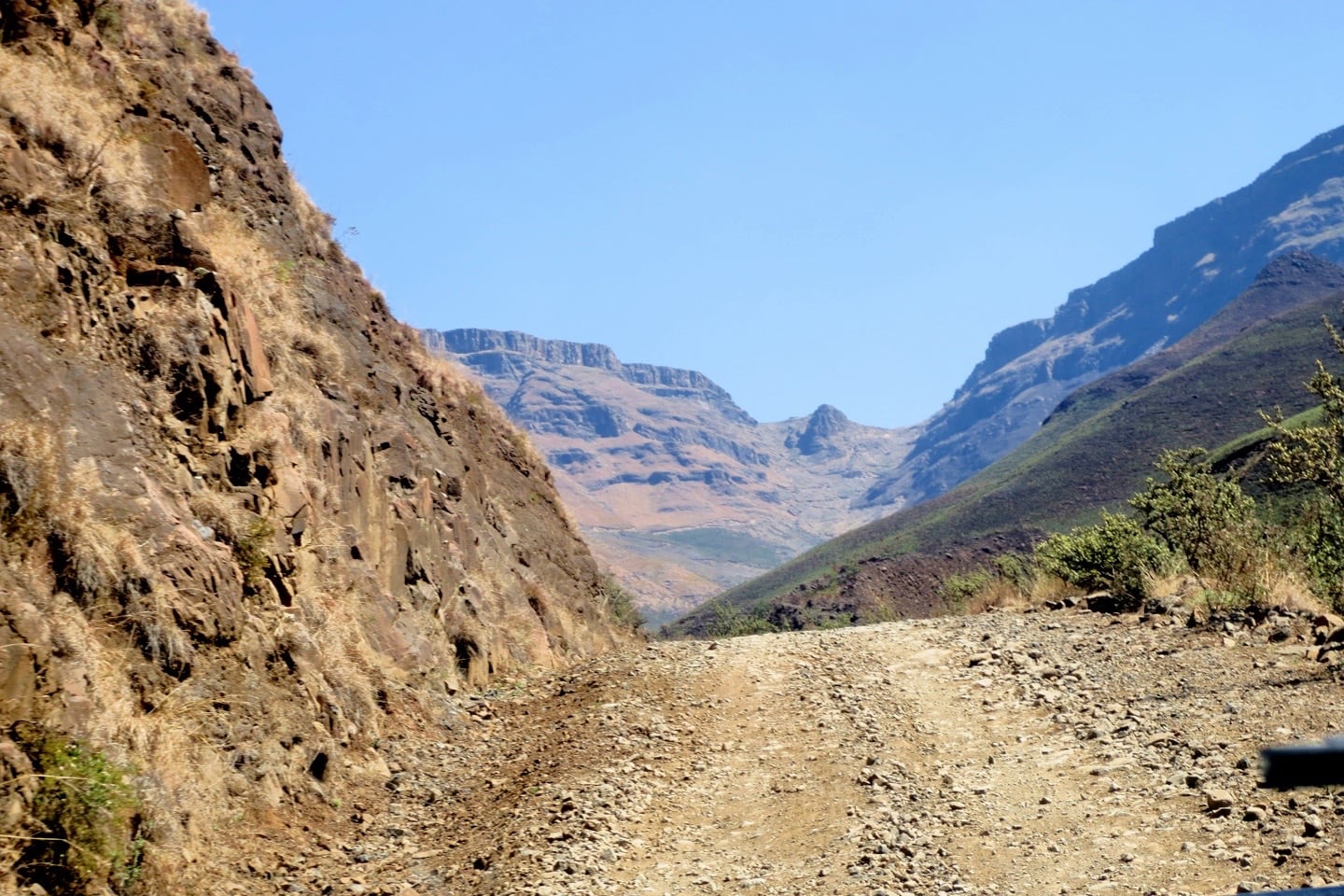
Heading up the road to the Pass, we look back to take in the valley and surroundings.
Not even half way up yet and it seems we are already on top of the world.


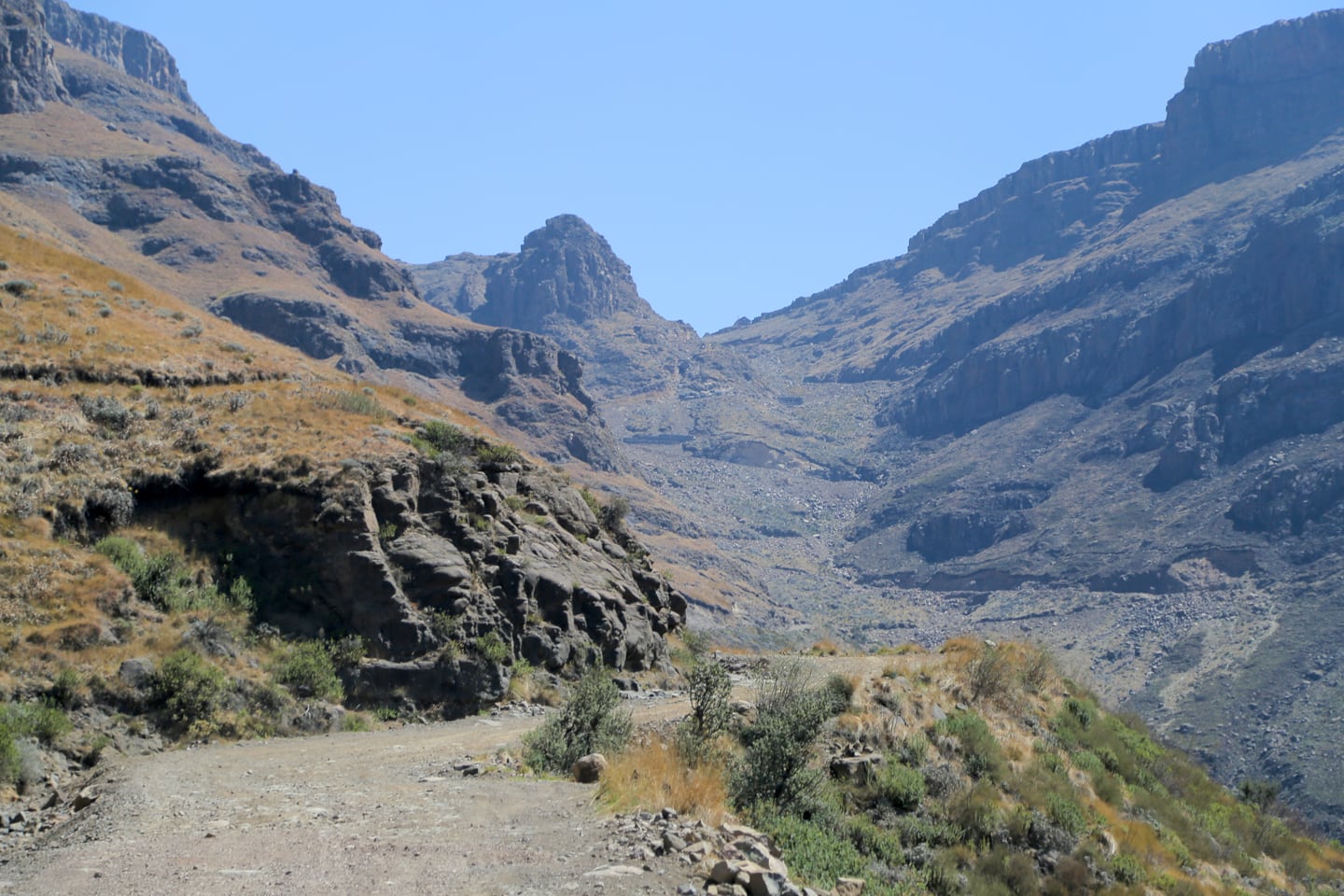
The winding road up to the pass, infamous for its hairpin curves, sheer drops, and regular vehicle accidents, has undergone major improvements in recent years.
At some point in the not too distant future, this whole thing may very well be paved and much of the adventure of the trip will be history.
For people like us (and tour guides like Stewart), that’s disappointing news — but quite good news for the locals who have to make the journey regularly.


Safely at the top, we peer down to the valley below and the wild, winding mess that constitutes the last mile of the pass road to the Lesotho border.
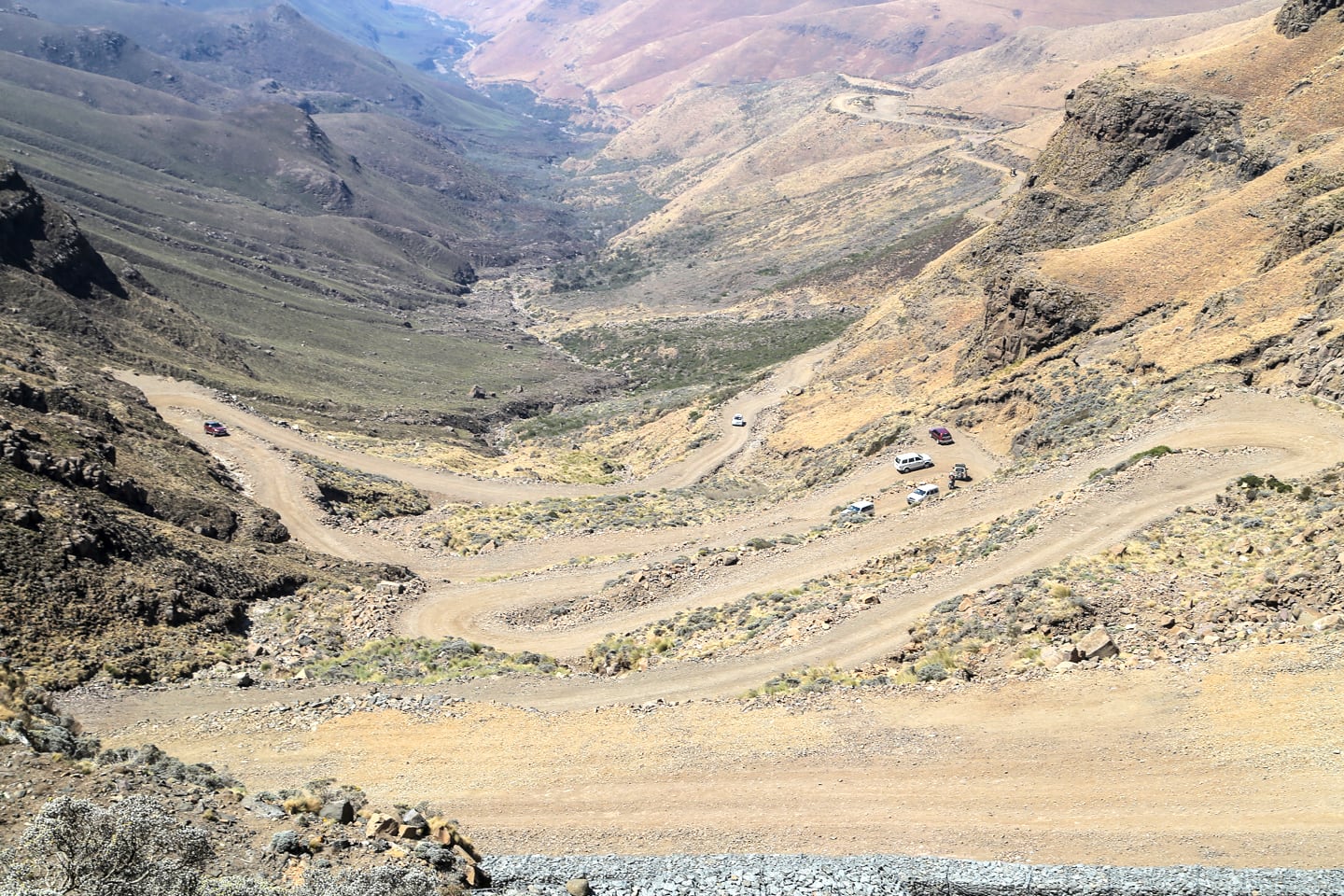
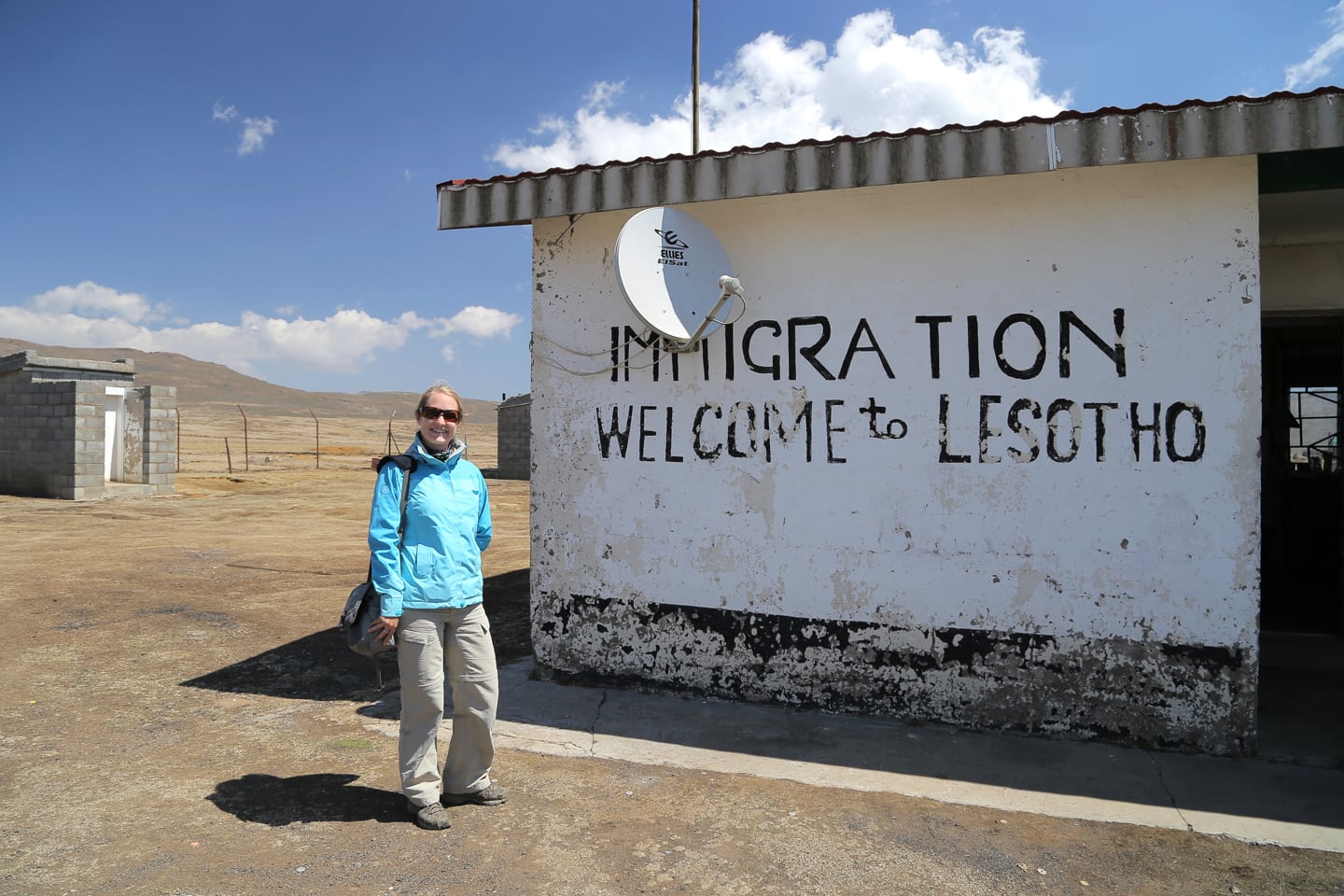
The Lesotho border post is a modest facility sitting on a barren, windswept plateau.

The Lesotho flag here has certainly seen better days. Given the driving wind up here, however, I can’t imagine these flags have a very long lifespan.

The road may be much improved, but it is still not to be taken lightly by drivers.
These are the remains of a minibus taxi which, just days prior to our visit, missed one of the hairpin turns and rolled over the edge, landing on the hairpin turn below.
Fortunately, it was only carrying a few passengers, none of which were seriously injured.
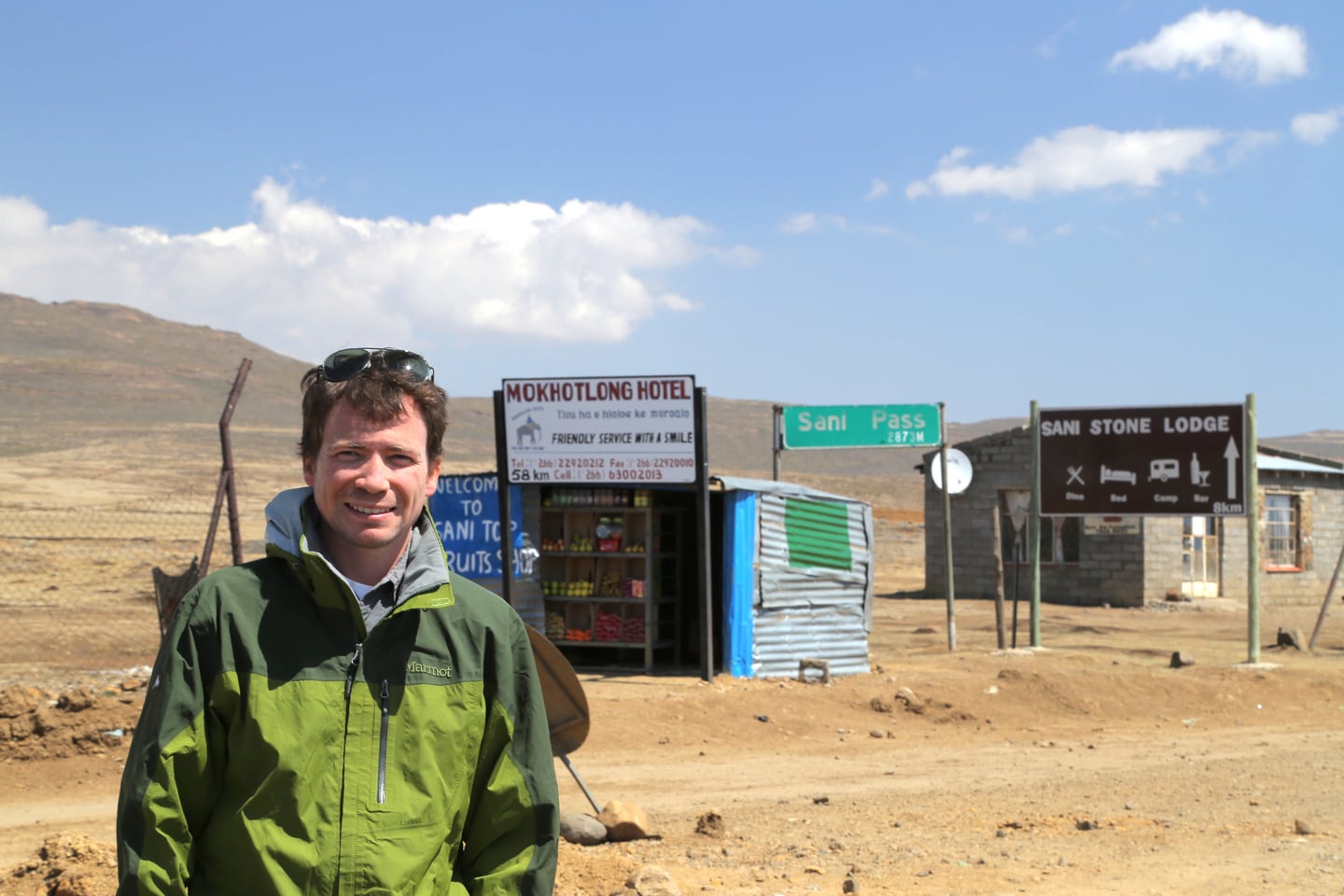
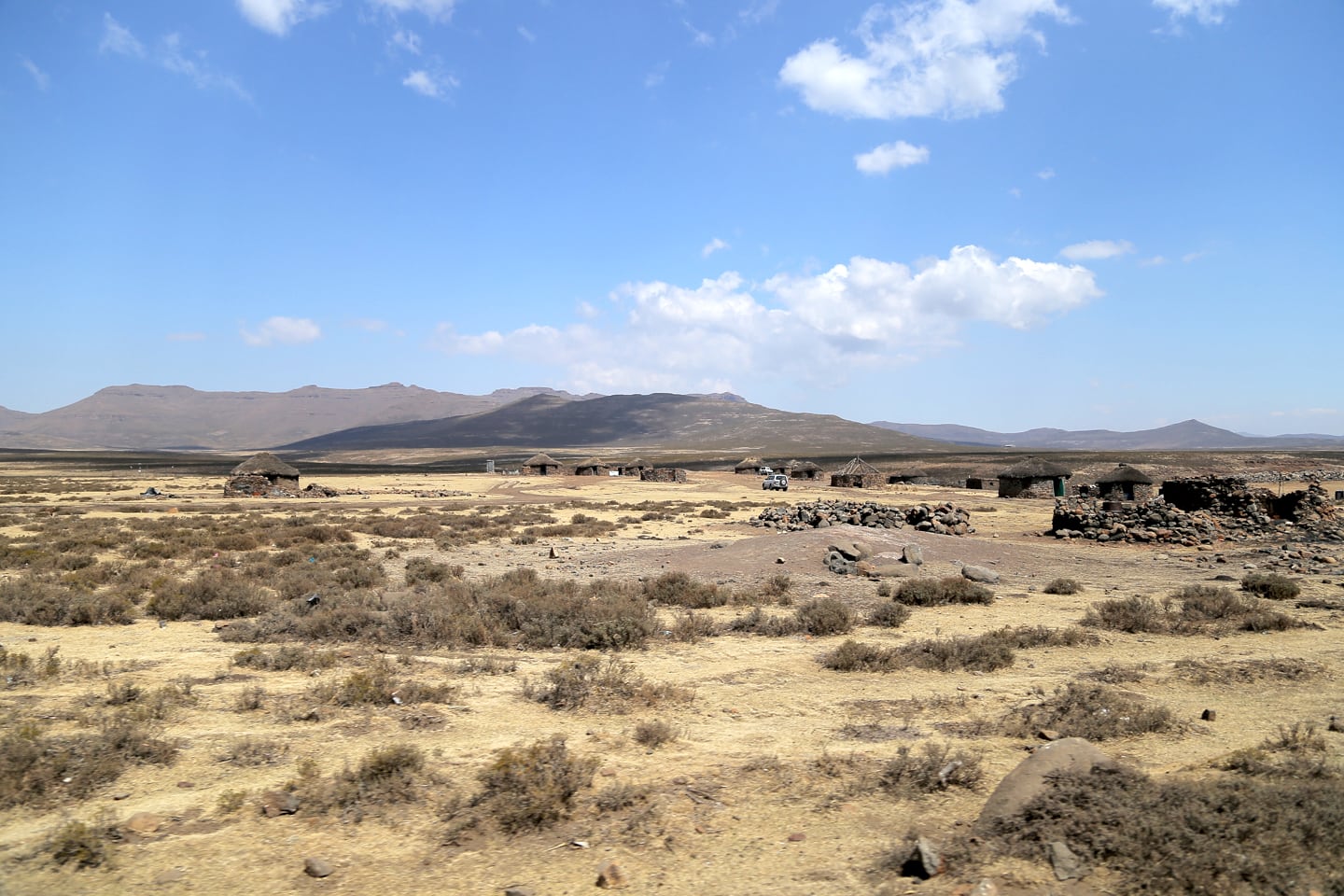
Not much on the top…but a few scattered settlements, more like trading posts.
The population in these parts of Lesotho swells considerably during the warmer months when shepherds relocate to the area for the season.
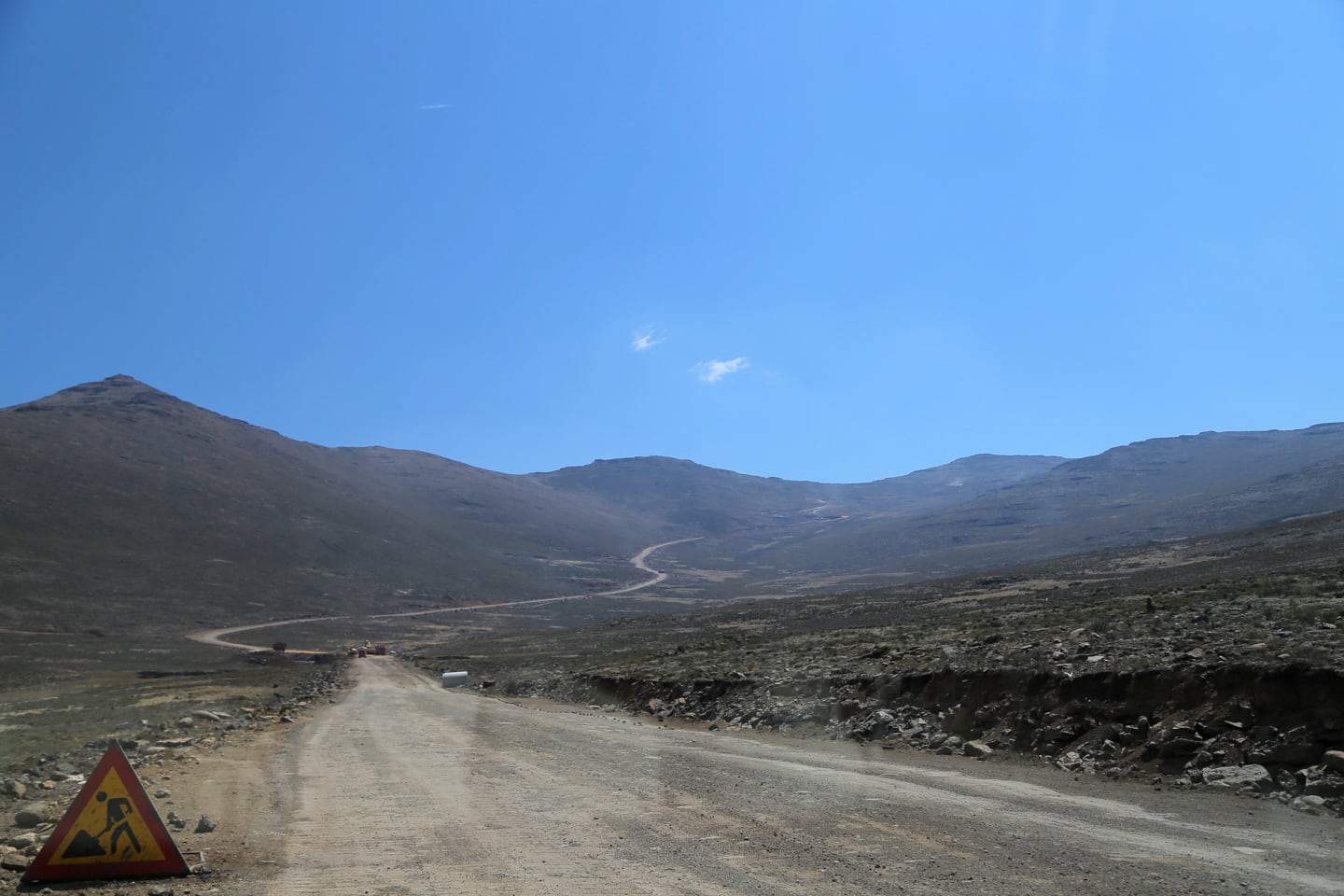
Perhaps most striking about this particular corner of Lesotho isn’t the shepherds huts or the trading posts, but all of the large-scale road construction driven primarily by the Chinese.
The Chinese are in the process of improving the highway here, widening it to four lanes and eventually laying tarmac. Now, what the Chinese want with the region is anybody’s guess.
Deeper into the interior, there is a small ski resort, but our guide doesn’t seem to think the Chinese are interested in investing in ski slopes. Some sort of mineral extraction would be the most logical assumption. But the details unsurprisingly remain a mystery.
Nonetheless, the Chinese have a contract to improve this road to nowhere, and they are moving ahead, full bore, doing what the Chinese seem to specialize in doing in the Africa hinterland these days: blowing up hilltops and making a lot of noise.

Along the way, Stewart points out a number of Ice Rats, the most common animal you’re bound to see in these parts, only surpassed perhaps by goats and sheep, depending on the season.
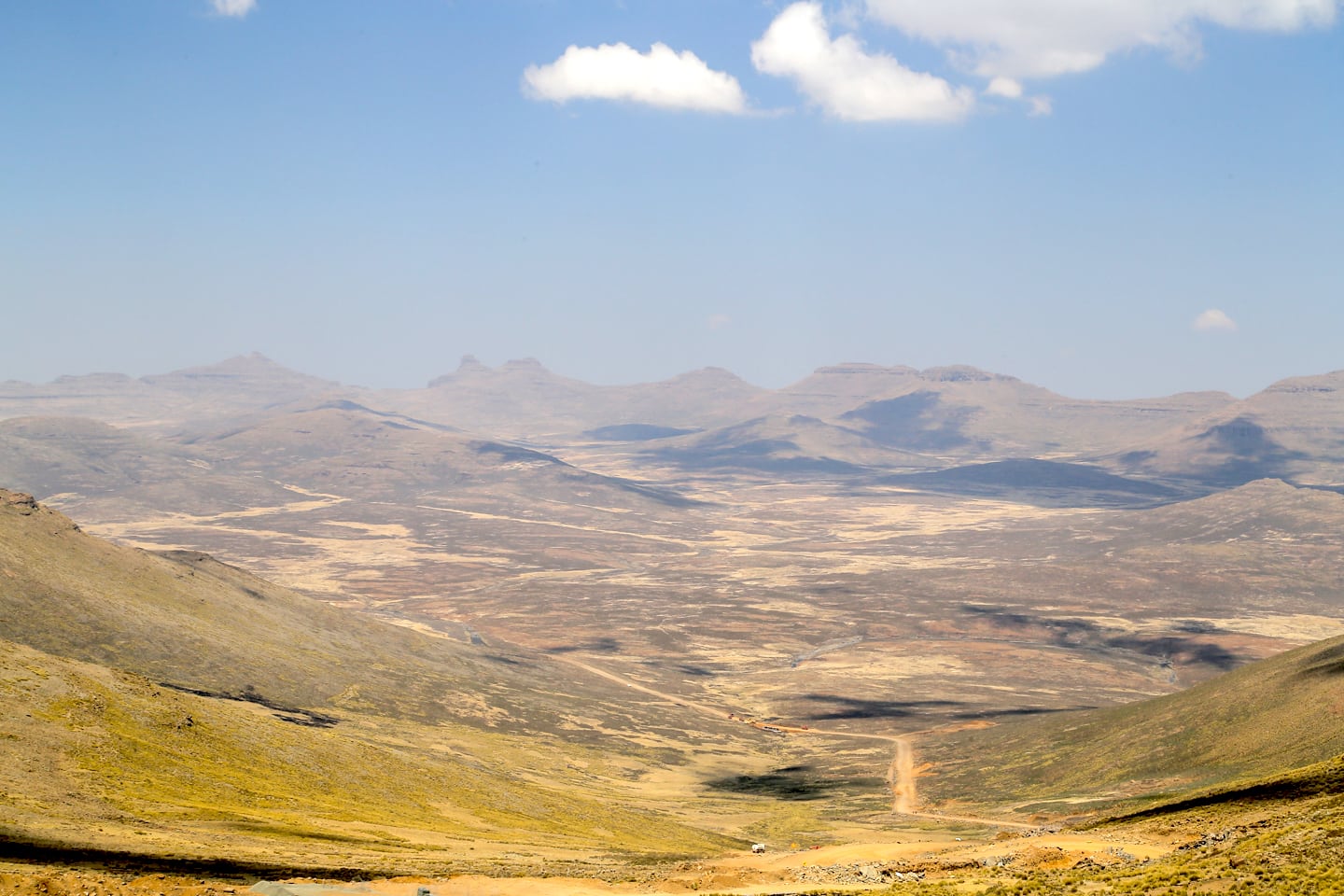
At one point, we pull over to take in the view of the Giant’s Cup, a mammoth formation characterized by the long slope connecting two of the highest Drakensberg peaks.
The highest peak in South Africa (and second highest in Africa) is not far from where we are standing right now.
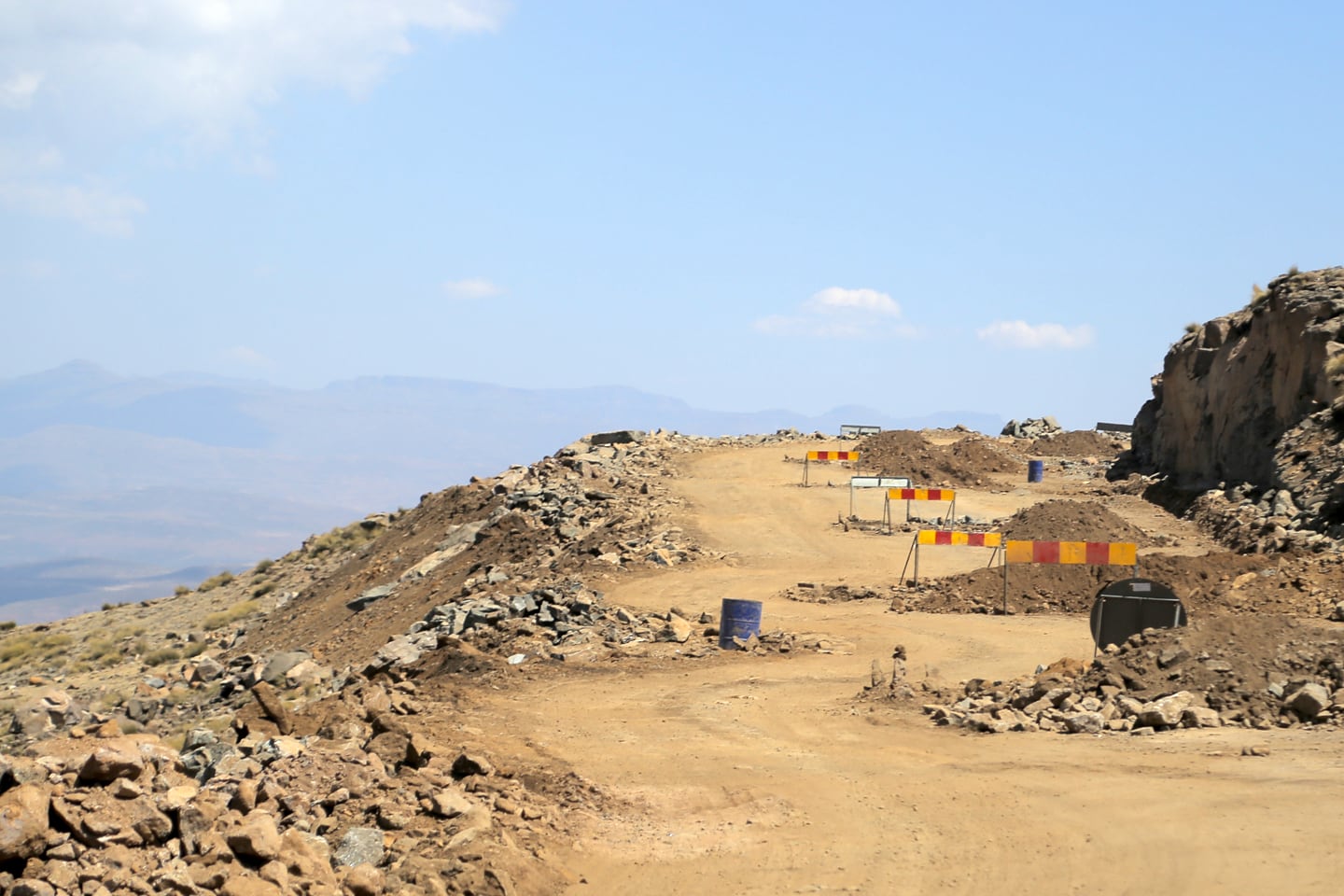
Onward and upward to our lunch spot! But not after passing through this gauntlet of roadwork.
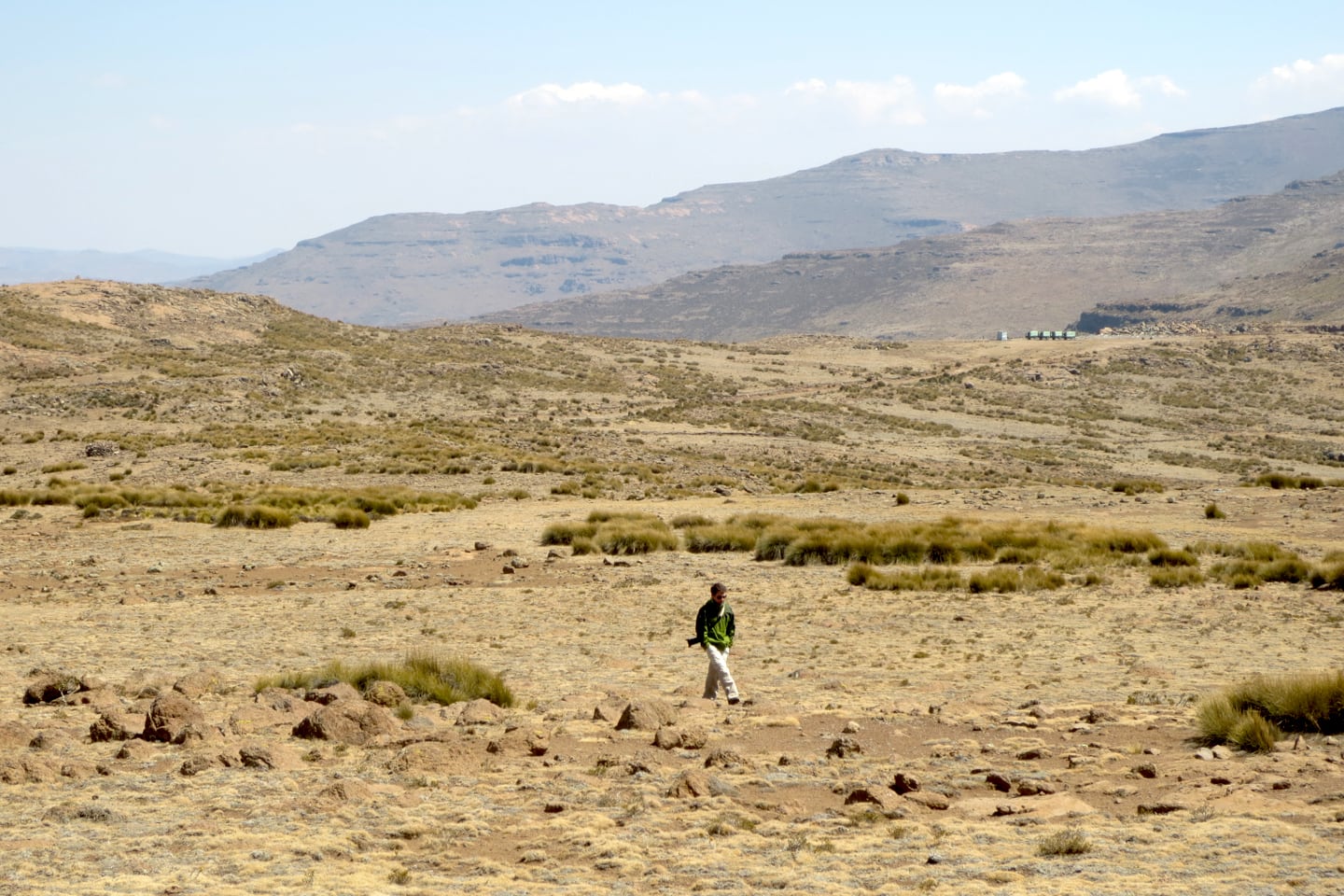
We leave the Land Rover and follow our guide up a hill. The air is noticeably thinner, and the landscape is stark and strangely beautiful — like being on another planet.

We reach our lunch stop, which happens to coincide with the highest elevation of the day: 10,691 feet (or 3,258 meters).
By the way, a really handy app for measuring these things is the aptly named app, My Altitude, which, among other features, will allow you to take pictures with your GPS coordinates, altitude, and date/time embedded. I definitely don’t use this enough.

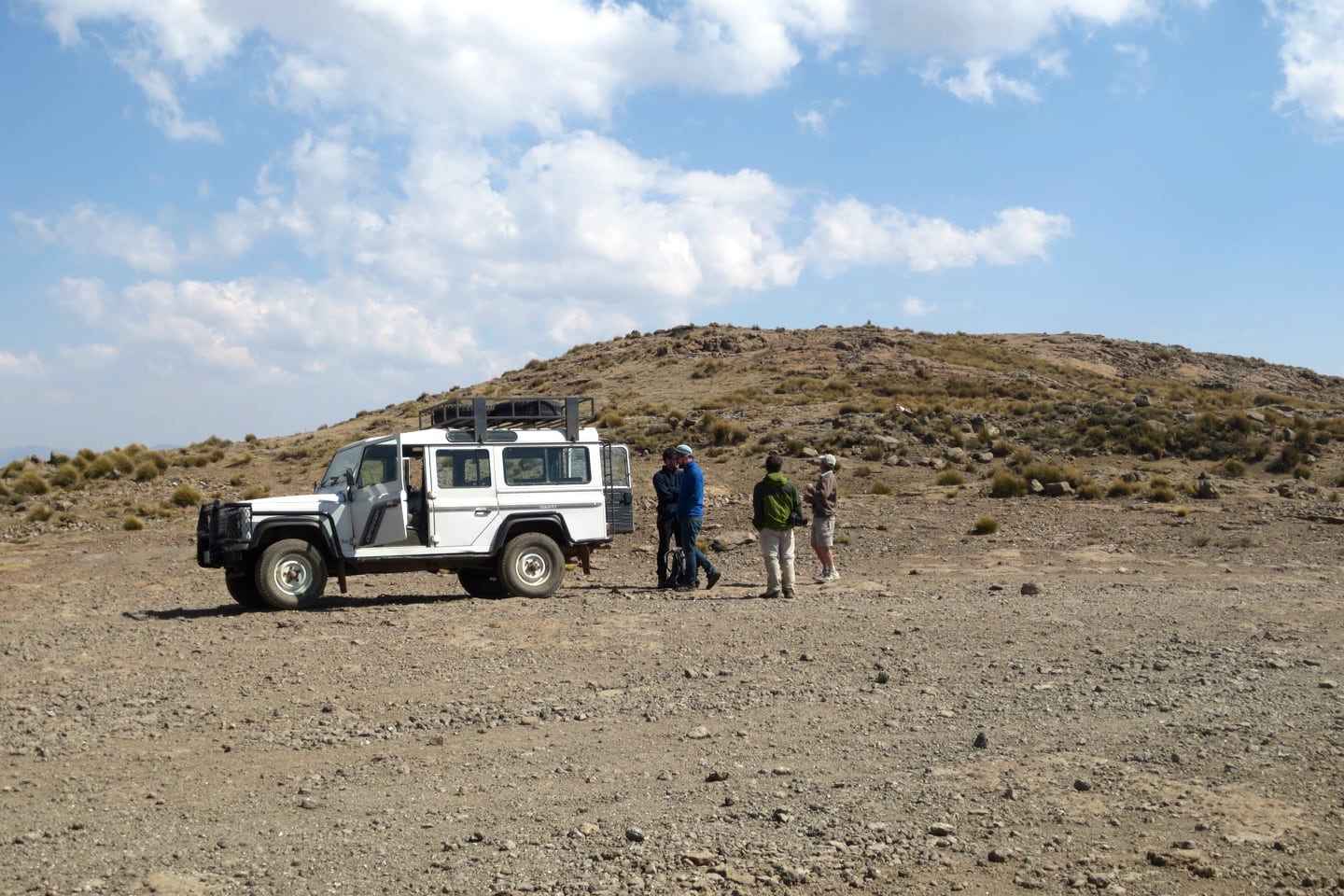
We feel very fortunate to have such a small group today — only four (two Germans and us) and our guide.
We passed a handful of other tour companies on the way up here who had many people crammed into various sizes of 4x4s. In comparison, the Land Rover felt quite luxurious, with a lot of room to spread out.
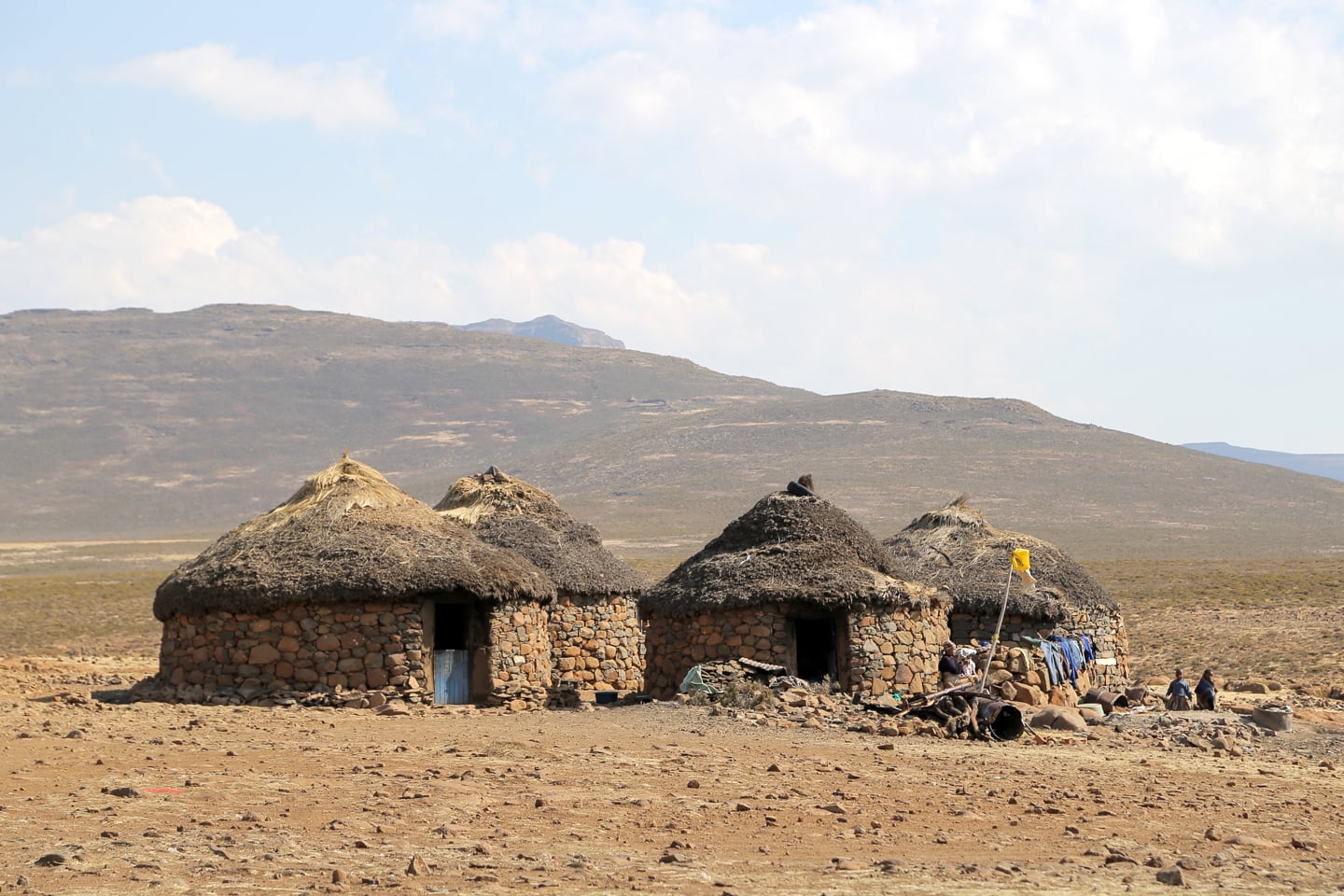
On our way back to Sani Pass, we make a stop at a trading post settlement to visit a woman who sells a variety of items, including some handicrafts made by community members.
The community is made up entirely of women, all of whom spend weeks, or months, manning these posts, isolated from the rest of their families.
Each shop generally sells something different, and their stock is always changing. They indicate what they are selling on any particular day based on the color of the flag they hoist outside of their shop.
Depending on the color, a flag may indicate bread, beer or other goods. The main clientele for these shops are nomadic herders (men) or, men traveling back and forth from jobs in South Africa, and lately, workers working on the roads.

This woman has just returned from visiting her children who live a few hours away to attend school. She gets to see her children once every few weeks on average.
The night’s can get bitterly cold and business can be incredibly slow at times. The women use dried sheep dung (pictured below) to cook and to warm their rondavels with.

One woman in the settlement speaks English very well, and most of the tour guides choose to take their groups to her, as none of the other women speak English well (though most understand much).
Our guide, being from the area, is able to speak a common local dialect, and thus chooses to take us to another woman who guides don’t visit as often (due to her lack of English skills).
We didn’t know this at first, and the meeting seemed initially strained. But once we learned that she did indeed understand (and speak a little English), and that our guide was trying to do something different and give someone else business who might not otherwise have received it, it made the visit seem less superficial.
Also, it helps that our guide pre-arranged some sort of payment for her time (and her fresh bread and beer), so that the atmosphere is much more comfortable and we don’t feel pressured to buy anything we might not want.
She seems happy to have us, and we’re happy to be invited into her home and sample some of her delicious homemade bread and homemade traditional beer.
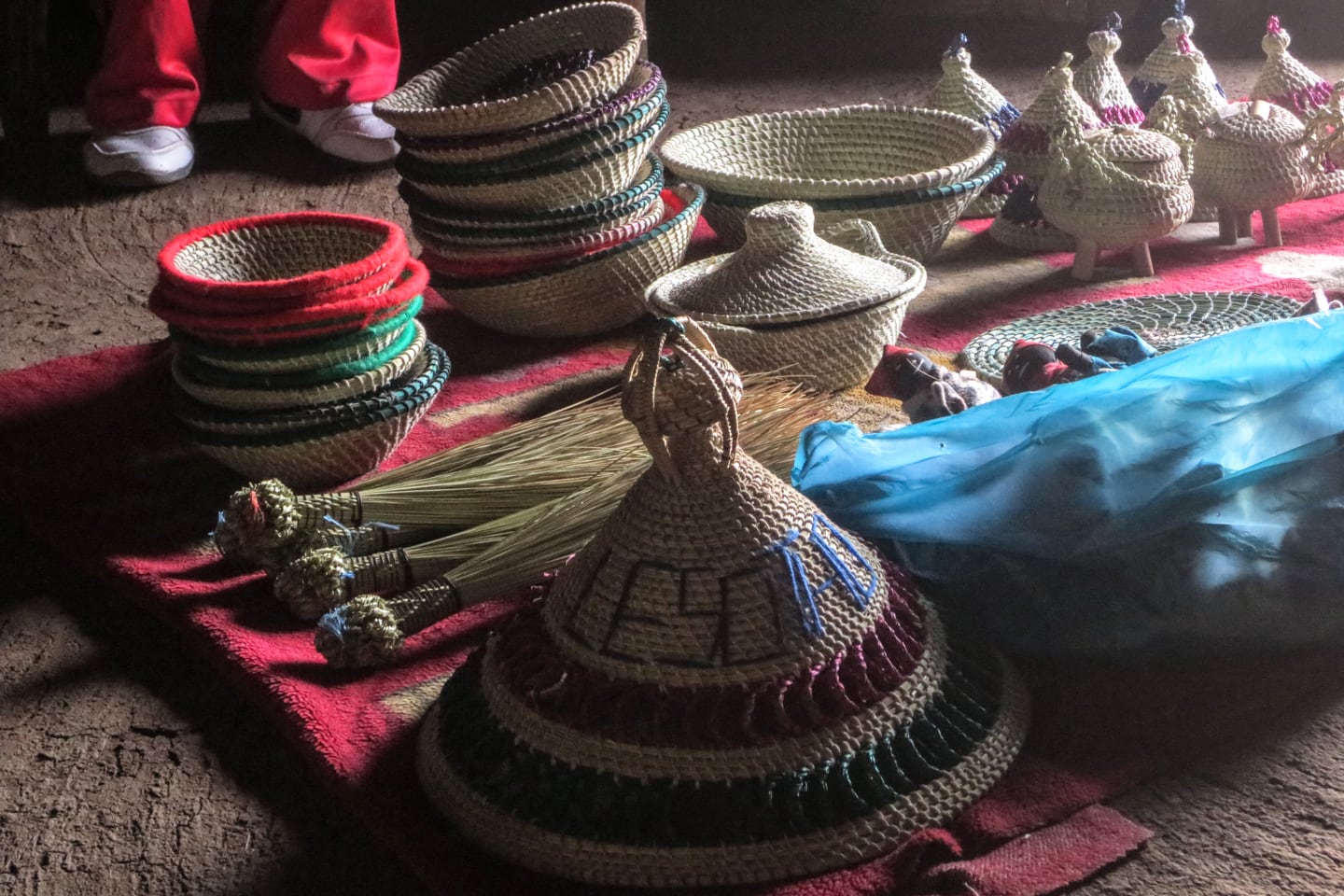

A lonely outhouse sits against a backdrop of a very ambitious and completely unnecessary Chinese bridge span.
Stewart says he’s never seen the water in the river below come within several feet of jumping its banks, but the Chinese insisted on a massive concrete bridge, 30 feet above the river, just ’cause they can…I guess.
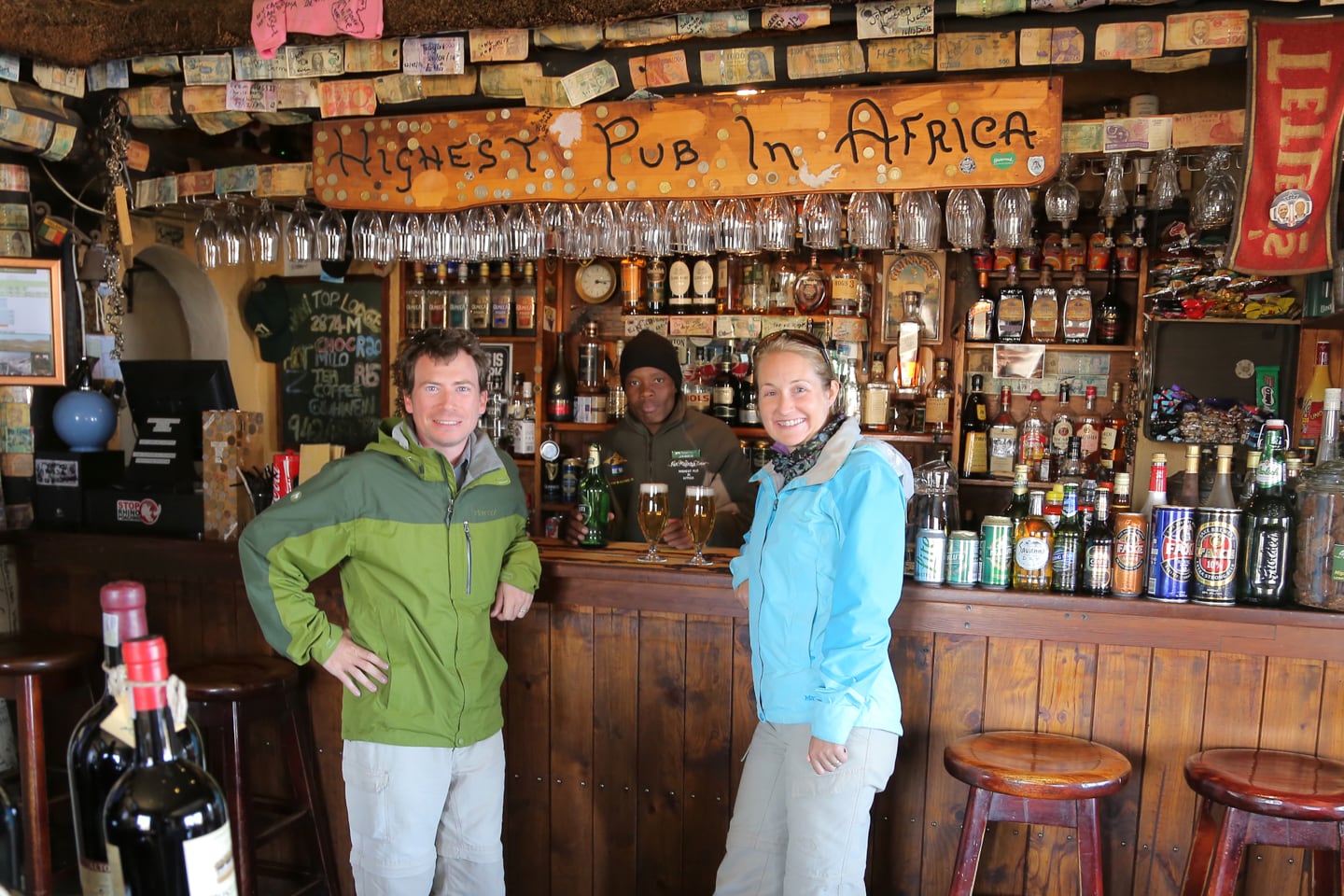
And now, the moment many of you have been waiting for! A beer at the Highest Pub in Africa!
Lori and I ordered up the Lesotho beer, Maluti, as it only seemed fitting.

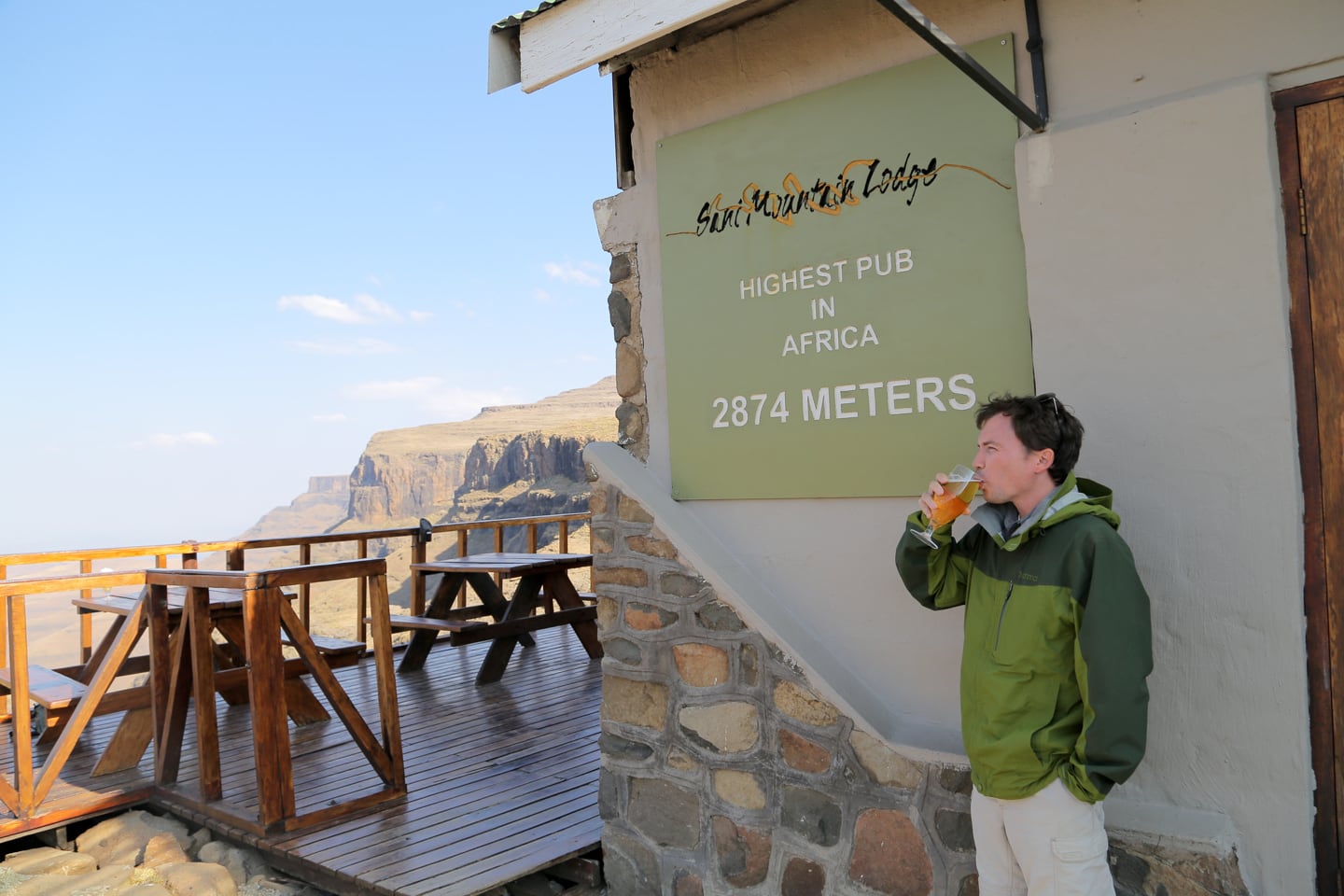
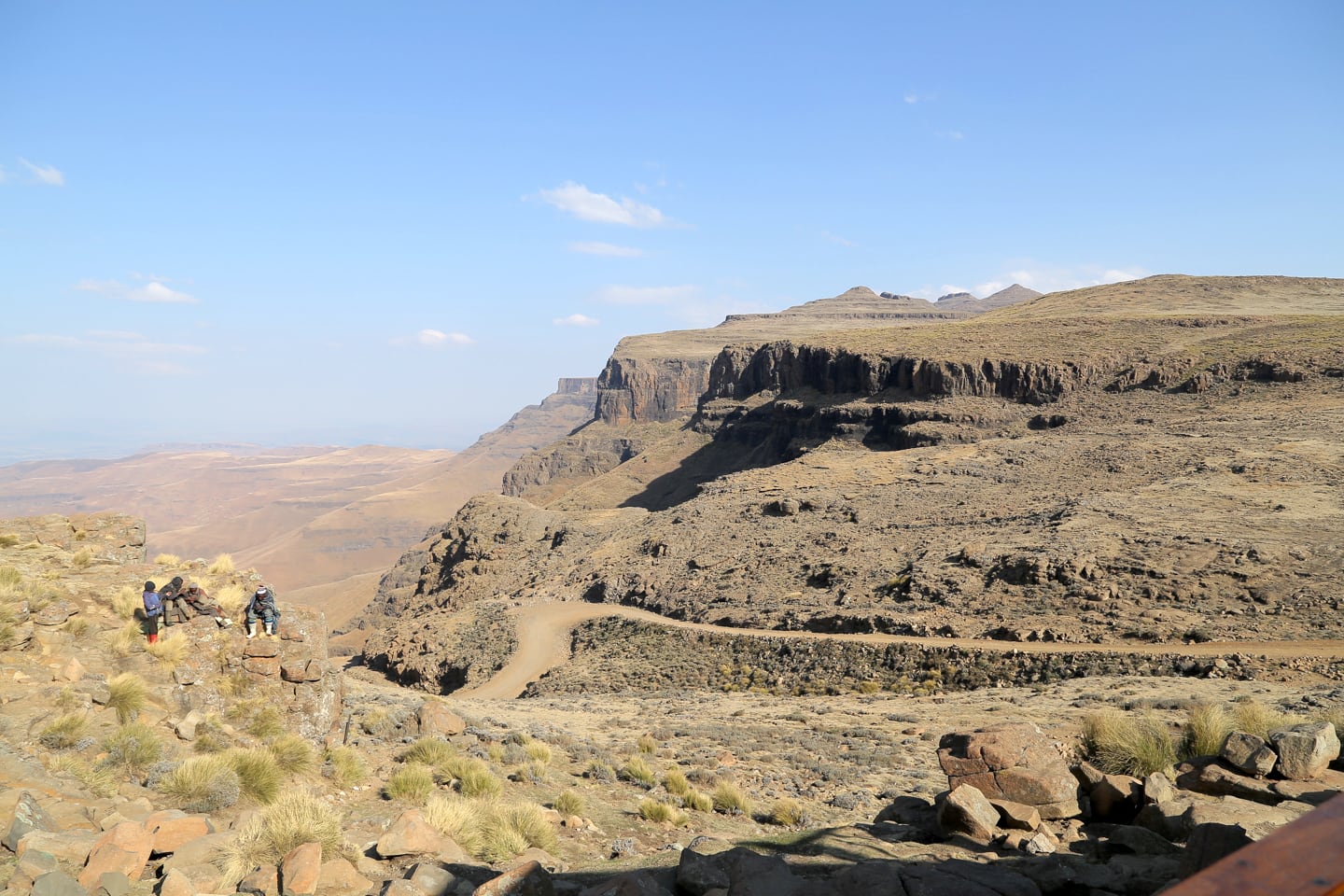
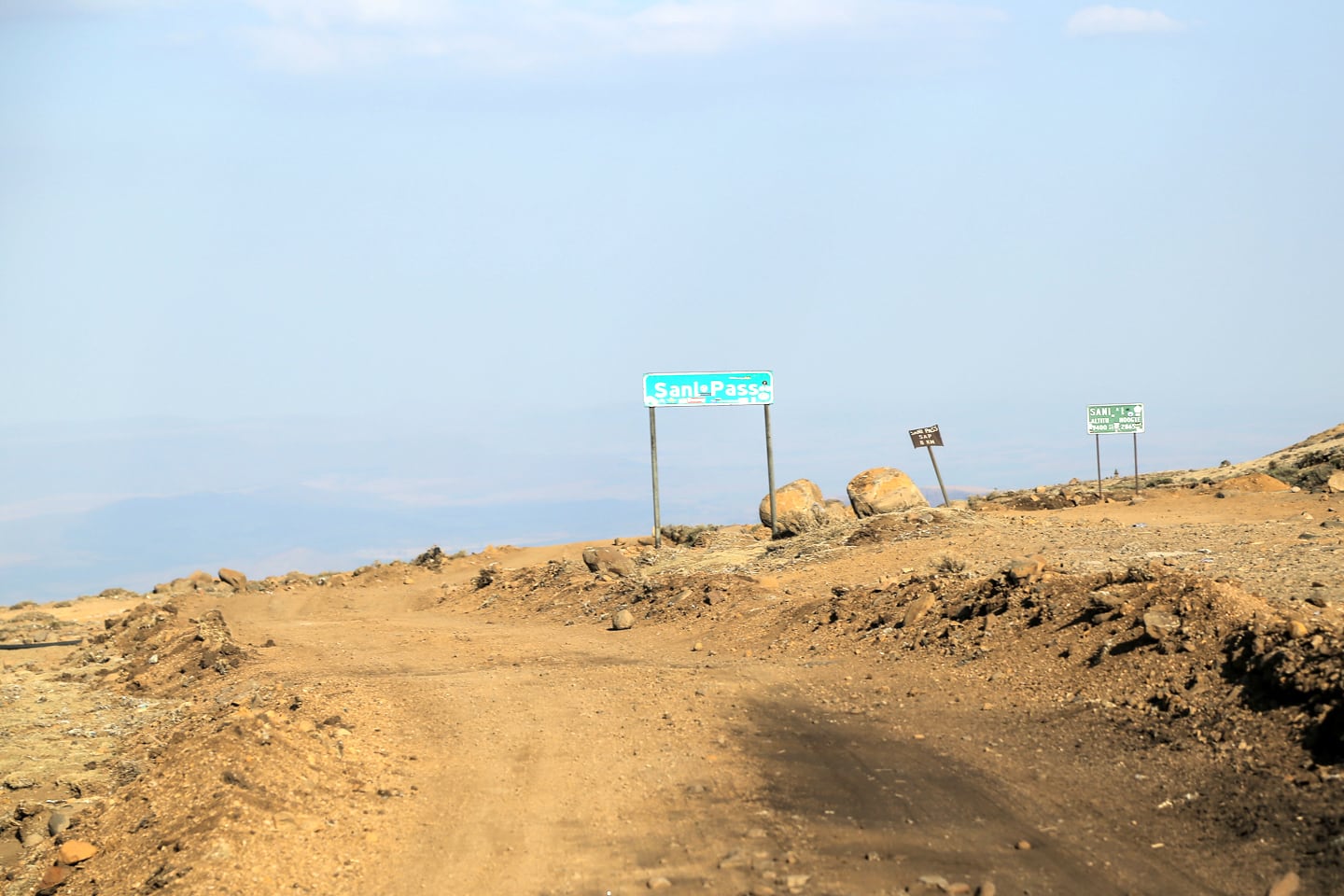
After our beers on high, we loaded up the vehicle one more time, and began the slow and arduous process of making our way back down the mountain.
Despite the many improvements, the gravel remains very loose and the road is very steep.
Take one of these corners just a little too fast and you’ll end up like the minibus taxi earlier in this post.
Thankfully, Stewart is an incredibly adept driver, guiding us safely and slowly back down to the valley.

Sundowners at Sani Lodge Backpackers
Back in the safety of the lodge, we cap off a near-perfect day of cross-border adventure with a bottle of Nederburg wine.
I used to joke with Lori back in the U.S. about Nederburg, because it was the one bottle of wine I could buy in the small town in Mozambique that I lived in for two years (the rest came in a box and bordered on the disgusting).
I recall the Nederburg being quite good, but never thought of it as an exceptional wine.
But in South Africa, apparently it is regarded with some level of esteem, perhaps largely due to the fact that it sponsors one of SA’s most popular television shows: Top Chef South Africa.
We actually tried to find the winery on our Winelands wine tour day — had directions and GPS coordinates and everything, asked around town when we couldn’t find it — but still, we never found it.
Either way, the Baronne we had was quite good, and a perfect cap to a memorable day.

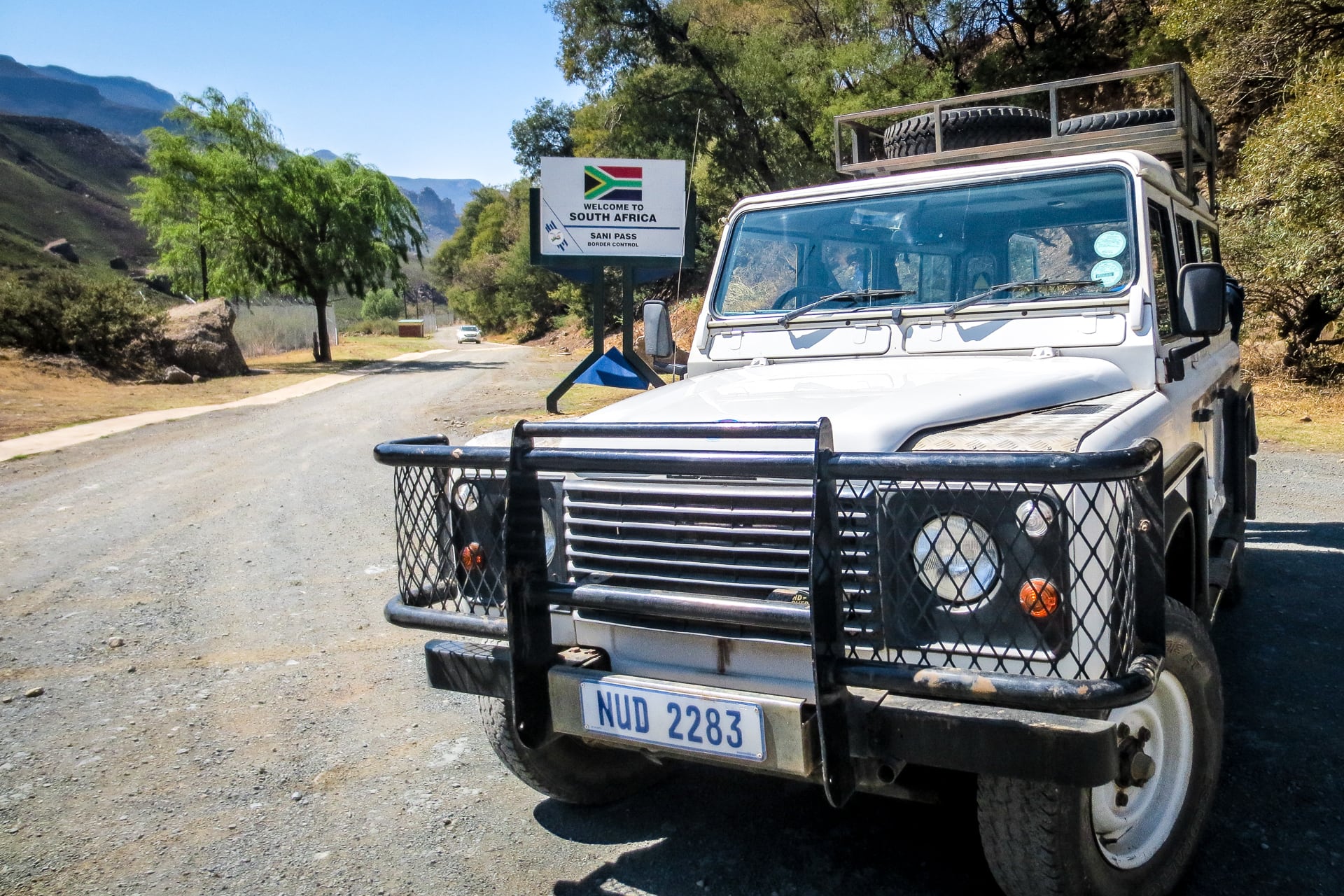
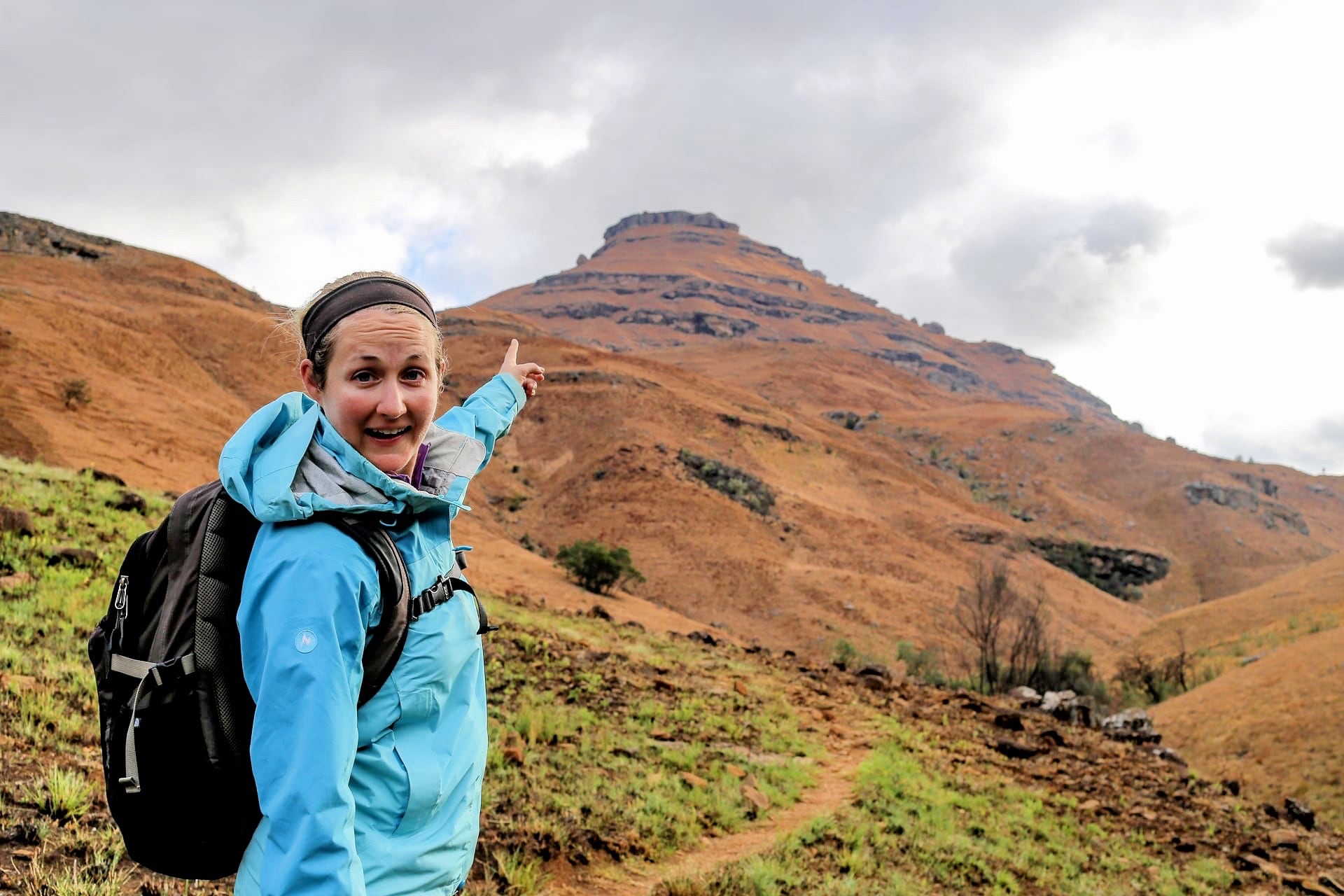
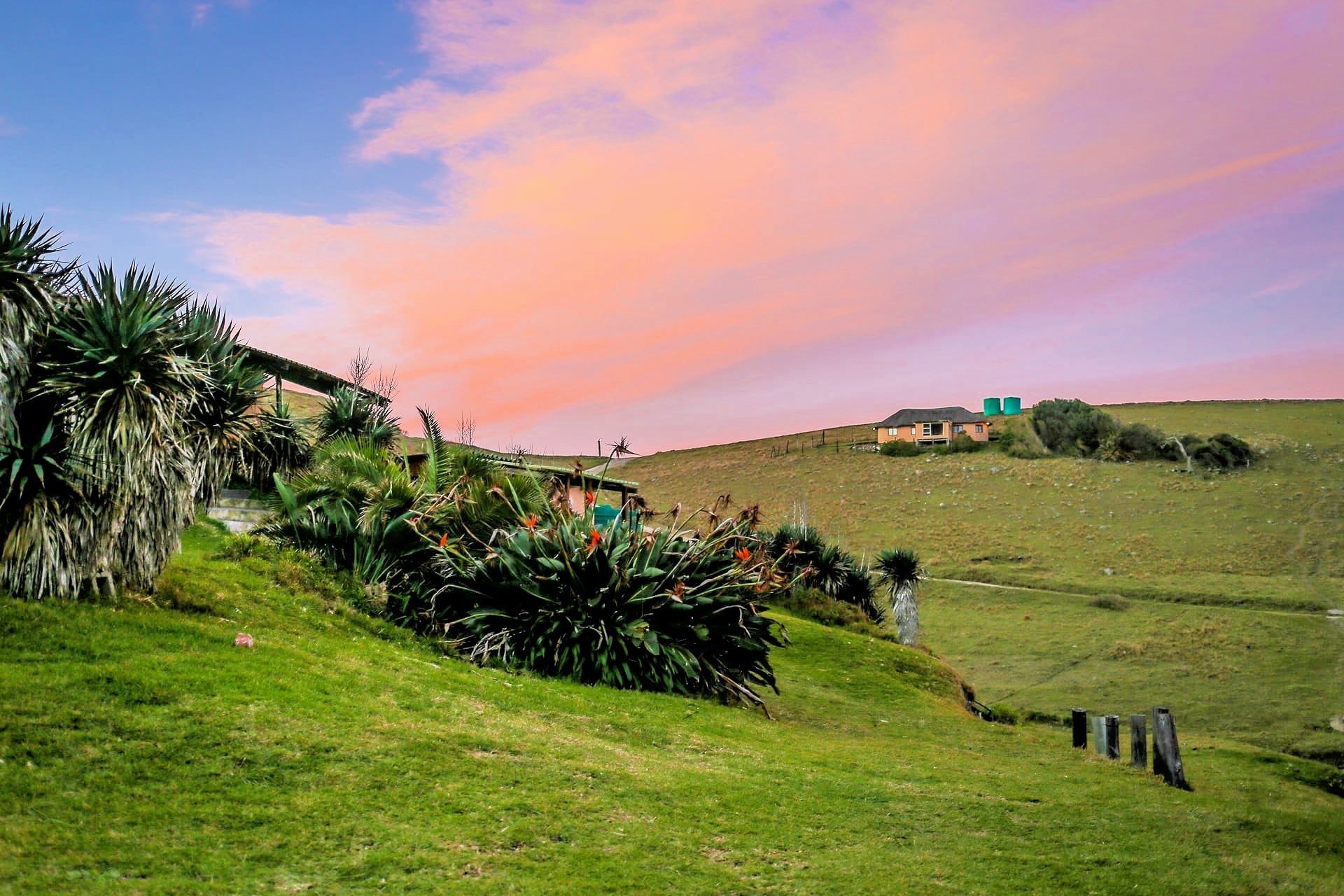
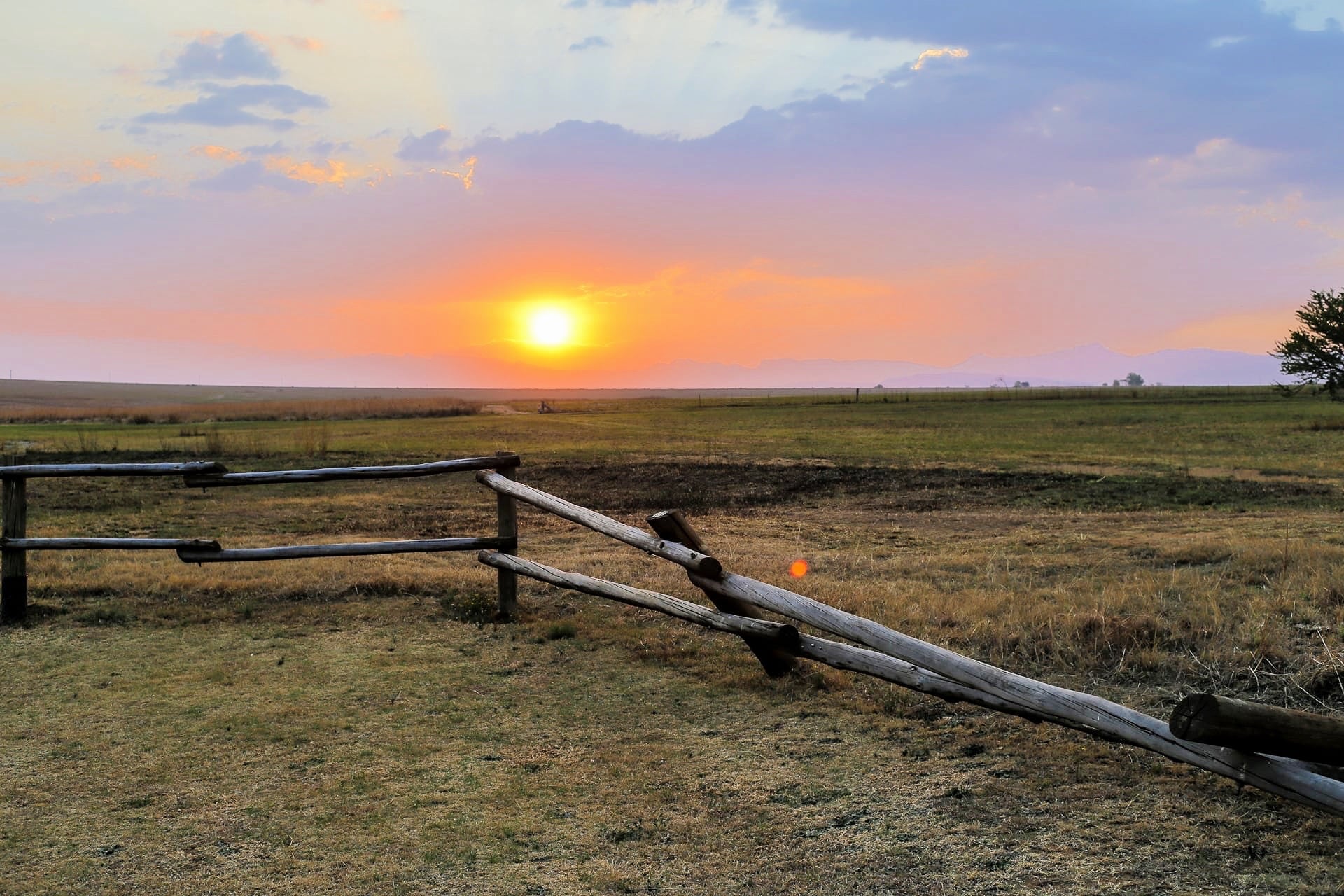
Happy Birthday, David! Sounded like an amazing trip!